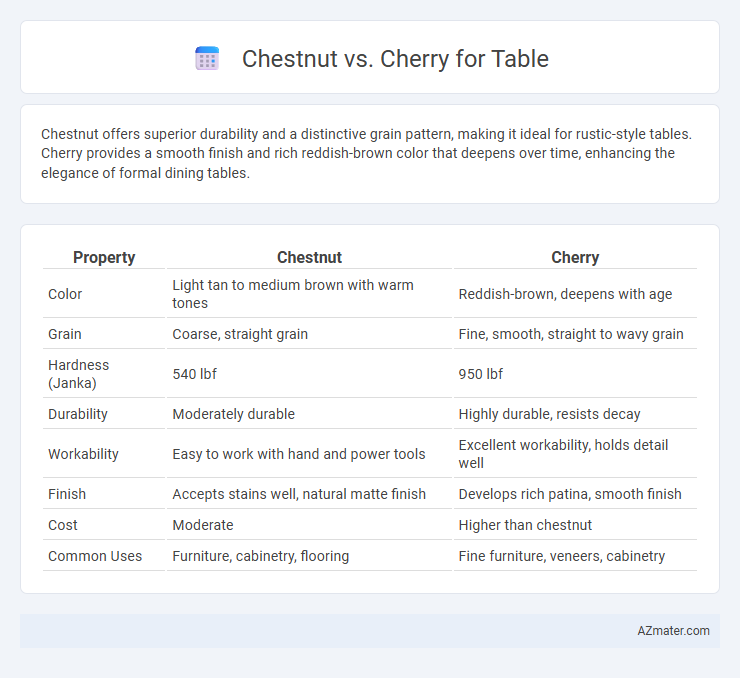Chestnut offers superior durability and a distinctive grain pattern, making it ideal for rustic-style tables. Cherry provides a smooth finish and rich reddish-brown color that deepens over time, enhancing the elegance of formal dining tables.
Table of Comparison
| Property | Chestnut | Cherry |
|---|---|---|
| Color | Light tan to medium brown with warm tones | Reddish-brown, deepens with age |
| Grain | Coarse, straight grain | Fine, smooth, straight to wavy grain |
| Hardness (Janka) | 540 lbf | 950 lbf |
| Durability | Moderately durable | Highly durable, resists decay |
| Workability | Easy to work with hand and power tools | Excellent workability, holds detail well |
| Finish | Accepts stains well, natural matte finish | Develops rich patina, smooth finish |
| Cost | Moderate | Higher than chestnut |
| Common Uses | Furniture, cabinetry, flooring | Fine furniture, veneers, cabinetry |
Introduction to Chestnut and Cherry Wood
Chestnut wood, known for its durability and warm, rich hues, features a straight grain and coarse texture, making it ideal for rustic and sturdy table designs. Cherry wood offers a smooth, fine grain with a reddish-brown color that deepens with age, prized for its elegant finish and workability in high-end furniture. Both woods provide unique aesthetic and structural qualities, influencing table style and longevity based on grain pattern, hardness, and color development over time.
Appearance and Grain Comparison
Chestnut wood features a coarse, open grain with a pale to medium brown hue, often displaying prominent growth rings that give a rustic, textured appearance. Cherry wood exhibits a fine, closed grain with a rich, reddish-brown color that deepens beautifully over time, offering a smooth, elegant finish ideal for refined tabletops. The contrast between chestnut's rugged, natural look and cherry's polished, warm sheen makes each wood distinctively suited for different design aesthetics in table construction.
Durability and Hardness Differences
Chestnut wood exhibits moderate durability and hardness, making it suitable for tables that require a balance of strength and workability. Cherry wood ranks higher in hardness on the Janka scale, offering superior resistance to dents and scratches, which enhances table longevity under frequent use. The durability of cherry also surpasses chestnut, providing a more robust surface ideal for high-traffic environments.
Color and Aging Over Time
Chestnut wood displays a rich, warm golden-brown color that deepens and develops a patina with age, enhancing its rustic and traditional appeal. Cherry wood starts with a light pinkish tone that gradually darkens to a deep reddish-brown over time, creating a smooth and elegant transformation. Both woods age beautifully, but chestnut emphasizes a vintage, earthy look while cherry offers a more polished and refined aesthetic for tables.
Workability and Craftsmanship
Chestnut wood offers moderate workability with a coarse texture that machines and sands smoothly, making it suitable for traditional craftsmanship and furniture with rustic appeal. Cherry wood is highly favored for its fine, straight grain and smooth finish, allowing for intricate detailing and superior carving, enhancing its desirability in high-quality, polished table designs. Both woods respond well to hand tools and finishes, but cherry stands out for its ease in achieving a refined surface and longevity in intricate craftsmanship.
Cost and Availability
Chestnut wood is generally more affordable than cherry, making it a cost-effective option for tables without sacrificing quality. Availability of chestnut has increased due to reforestation efforts, while cherry wood remains popular but pricier because of its slower growth and higher demand. Choosing between chestnut and cherry depends largely on budget constraints and the desired aesthetic, with chestnut providing a rustic, lighter look and cherry offering a rich, reddish hue.
Environmental Impact and Sustainability
Chestnut wood boasts a lower environmental impact due to its rapid growth rate and widespread availability, making it a more sustainable choice for table production. Cherry wood, while durable and aesthetically pleasing, grows more slowly and is less abundant, leading to higher environmental costs and greater resource depletion. Choosing chestnut for tables supports sustainable forestry practices and reduces carbon footprint compared to cherry wood.
Best Uses for Chestnut vs Cherry Tables
Chestnut tables excel in durability and showcase a rustic, textured grain ideal for farmhouse and traditional settings, offering exceptional resistance to dents and wear. Cherry tables provide a rich, warm hue with a smooth, fine grain that deepens beautifully over time, making them perfect for elegant, formal dining rooms and sophisticated interiors. Both woods complement hardwood flooring and classic decor, but chestnut's robustness suits heavy-use areas while cherry's refined finish enhances upscale, decorative spaces.
Maintenance and Care Tips
Chestnut wood requires regular sealing and oiling to prevent moisture damage and maintain its natural luster, while cherry wood benefits from periodic polishing to enhance its rich reddish hue and resist surface scratches. Both woods should be kept away from direct sunlight and extreme humidity fluctuations to avoid warping and discoloration. Using coasters and cleaning spills promptly helps preserve the finish and extend the lifespan of chestnut and cherry tables.
Choosing the Right Wood for Your Table
Chestnut offers a durable, medium-hardness wood with a warm, prominent grain ideal for rustic or traditional tables, while cherry provides a smoother texture, rich reddish-brown color, and excellent aging potential that darkens beautifully over time. Chestnut's strong resistance to decay makes it suitable for sturdy, long-lasting furniture, whereas cherry's fine grain and elegant appearance are preferred for refined, high-end tables. Selecting the right wood depends on desired aesthetics, durability requirements, and the table's intended use in your living space.

Infographic: Chestnut vs Cherry for Table
 azmater.com
azmater.com